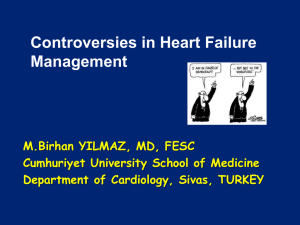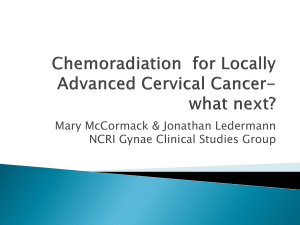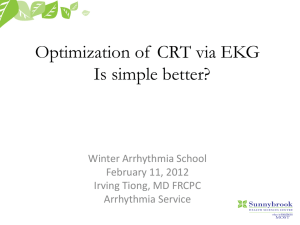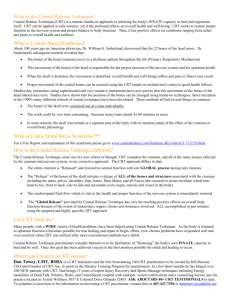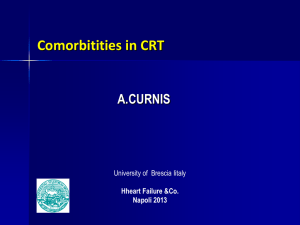Targeted Left Ventricular Lead Placement to Guide Cardiac
advertisement
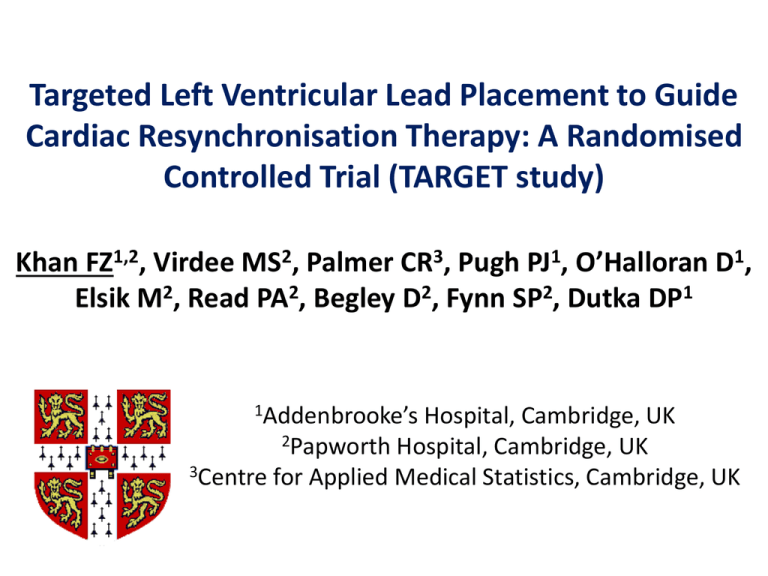
Targeted Left Ventricular Lead Placement to Guide Cardiac Resynchronisation Therapy: A Randomised Controlled Trial (TARGET study) Khan FZ1,2, Virdee MS2, Palmer CR3, Pugh PJ1, O’Halloran D1, Elsik M2, Read PA2, Begley D2, Fynn SP2, Dutka DP1 1Addenbrooke’s Hospital, Cambridge, UK 2Papworth Hospital, Cambridge, UK 3Centre for Applied Medical Statistics, Cambridge, UK Disclosures Disclosures: None Sponsorship: Papworth Hospital, Cambridge, UK Funding: NIHR UK Papworth Hospital, Addenbrooke’s Charitable Trust Trial Registration: ISRCTN19717943 Introduction • Cardiac Resynchronisation Therapy (CRT) has evolved as established treatment for advanced heart failure symptoms, impaired LV systolic function and intraventricular conduction delay • 30-40% of patients fail to gain significant clinical benefit • Left ventricular (LV) lead position has emerged as an important determinant of response LV Lead Position in CRT Higher response when pacing the latest site of contraction1 1 Lower response when pacing areas of scar2 Ypenburg et al J Am Coll Cardiol.2009;53(6):483-490 et al Circulation 2006;113(7):969-976. 2Bleeker Hypothesis • There have been no randomised controlled trials to investigate the impact of LV lead position • The TARGET study designed to prospectively assess the feasibility of a targeted approach to LV lead placement and the impact of LV lead targeting on CRT outcomes • We tested the hypothesis that targeted LV lead placement to the latest site of contraction and away from areas of scar would enhance CRT response when compared to usual (unguided) treatment Study Design Single blinded, randomised controlled trial, 2 UK centres Inclusion: Sinus rhythm, NYHA Class III/IV, LVEF<35%, QRS>120ms Baseline (all patients): LV volumes, EF, NYHA, 6MWT, MLHFLQ Randomisation CONTROL Group Standard CRT LV Lead Placement without echocardiographic guidance TARGET Group Targeted LV Lead Speckle Tracking Echocardiography used to identify optimal site and LV lead targeted to this site All CRT devices optimised using echo following implant Speckle Tracking Echocardiography to Identify Optimal Site – Latest Site Speckle Tracking Echocardiography to Identify Optimal Site – Scar Determination Speckle tracking radial strain imaging correlates with delayed enhanced CMR imaging for determination of scar1,2 In CRT patients, a <10% amplitude of radial strain at the LV pacing site has a high negative predictive value (91%) for response (LV reverse remodelling)3 1 Becker et al J Am Coll Cardiol 2008 51(15):1473-1481 2Delagado et al Circulation 2011 123 (1):70-8 3Khan et al J Am Soc Echocardiogr. 2010 23(11):1168-1176 LV Lead Targeting – TARGET Group Step 1: Identify optimal site as the latest site with an amplitude >10% to signify freedom from scar Step 2: Coronary sinus venography in steep left anterior oblique (LAO) view (50-90º) and coronary vein closest to optimal site identified Step 3: LV lead placed to optimal site (anterior, lateral, posterior or inferior in LAO view and basal or mid LV in the RAO view) Step 4: LV lead position correlated with echocardiographic data and described as: Concordant (pacing the optimal site) Adjacent (1 segment away) Remote (≥2 segments away from the optimal site) Study Endpoints Primary endpoint • Comparison of response rates between groups (≥15% reduction of LVESV at 6 months) Secondary endpoints • Clinical response rates (≥1 improvement in NYHA class) • All cause mortality • Combined mortality & heart failure hospitalisation Statistics: 80% power to identify a 20% difference in response rates between groups (one-sided α value of 0.05) Assessed for eligibility (n=247) Excluded (n= 27) •Inadequate images to perform speckle tracking echocardiography Randomized (n= 220) ALLOCATION TARGET Group (n=110) •Died prior to receiving CRT (n=1)* •Failure to implant an LV Lead (n= 4) CONTROL Group (n=110) •Died prior to receiving CRT (n=1) * •Failure to implant an LV Lead (n= 3) FOLLOW UP Lost to follow-up (n=6) * Died prior to 6 month follow up (n=3) Lost to follow-up (n=5) * Died prior to 6 month follow up (n=4) ANALYSIS *Excluded from analysis (n=7) All patients included for long term endpoints Total data analysed n=103 for primary and secondary endpoints *Excluded from analysis (n=6) All patients included for long term endpoints Total data analysed n=104 for primary and secondary endpoints Baseline Characteristics Age (mean ± SD) yrs Male n (%) NYHA III/IV Ischemic Cardiomyopathy n (%) Diabetes Mellitus n (%) QRS duration (mean ± SD) ms LVEDV (mean ± SD) ml LVESV(mean ± SD) ml LVEF (mean ± SD) % ACEI or ARB n (%) B-blockers n (%) Spironolactone n (%) IVMD (mean ± SD) ms AS-P Delay (mean ± SD) ms Target Group (n=110) 70 ± 9 85 (77) 95/15 62 (56) 30 (27) 161 ± 21 202 ± 66 157 ± 56 23 ± 6 104 (95) 78 (71) 63 (57) 45 ± 27 190 ± 136 Control Group (n=110) 71 ± 10 88 (80) 93/17 61 (56) 29 (26) 161 ± 23 200 ± 58 154 ± 52 24 ± 7 103 (94) 77 (70) 59 (54) 44 ± 24 177 ± 148 Latest Site and LV Lead Position Target Group (n=103) Control Group (n=104) Latest Site of Activation % Inferior Posterior Lateral Anterior Anteroseptal Inferoseptal LV Lead Position % Inferior Posterior Lateral Anterior Failed Implant P Value 0.961 13 38 32 9 4 4 14 41 31 7 4 3 0.443 12 35 46 3 4 6 38 47 6 3 LV Lead Targeting Target Group (n=103) Relationship of LV Lead to Late Site % (n) Concordant Adjacent Remote Scar at LV Lead Site % (n) Control Group (n=104) P Value 0.011 61 (63) 25 (26) 10 (10) 45 (47) 28 (29) 24 (25) 8 (8) 16 (15) 0.133 Procedural Characteristics Target Group Control Group P (n=103) (n=104) Value Implant Related Complications Total % (n) Failure to implant LV lead LV Lead Displacement (repositioning) Phrenic nerve stimulation (reposition) Device infection (extraction/re-implant) Pneumothorax Myocardial perforation Procedural Characteristics Procedural Length (mins) Screening time (mins) Screening dose (mGy/cm2) 0.991 13 (13) 4 (4) 5 (5) 1 (1) 1 (1) 1 (1) 1 (1) 14 (13) 3 (3) 6 (6) 2 (2) 1 (1) 1 (1) 1 (1) 139 ± 36 25 ± 14 133 ± 107 138 ± 42 19 ± 13 91 ± 69 0.823 0.031 0.024 Primary Endpoint Response Rates: TARGET vs. Control (70% vs. 55%, p=0.031) Absolute difference in the primary endpoint of 15% [95% CI (2%, 28%)] Secondary Endpoint Clinical Response Rates: TARGET vs. Control (83% vs. 65%, p=0.003) Target vs. Control All Patients: Effect of LV Lead Position All Patients: Effect of Scar OR 95% CI P value Univariate Regression Analysis Age Male Gender Ischaemic Aetiology QRS duration Scar at LV pacing site Dyssynchrony Concordant Lead 1.05 2.09 1.74 1.00 2.40 5.51 5.30 1.01-1.08 0.99-4.43 0.97-3.12 0.98-1.01 1.02-5.70 2.9-10.4 2.8 – 9.96 0.007 0.054 0.063 0.47 0.046 <0.01 <0.01 Multivariate Regression Analysis Age Male Gender Ischaemic Aetiology QRS duration Scar at LV pacing site Dyssynchrony Concordant Lead 1.06 2.85 1.54 0.99 3.06 5.95 4.43 1.01-1.11 1.02-7.96 0.69-3.43 0.97-1.01 1.01-9.26 2.78-12.7 2.09-9.40 0.018 0.045 0.29 0.22 0.048 <0.01 <0.01 Conclusions • The TARGET study is the first randomised controlled trial of LV lead targeting • Targeted LV lead placement is feasible and associated with enhanced CRT response • Concordant LV lead placement, baseline dyssynchrony and pacing away from areas of scar are strongly related to improved CRT outcomes

